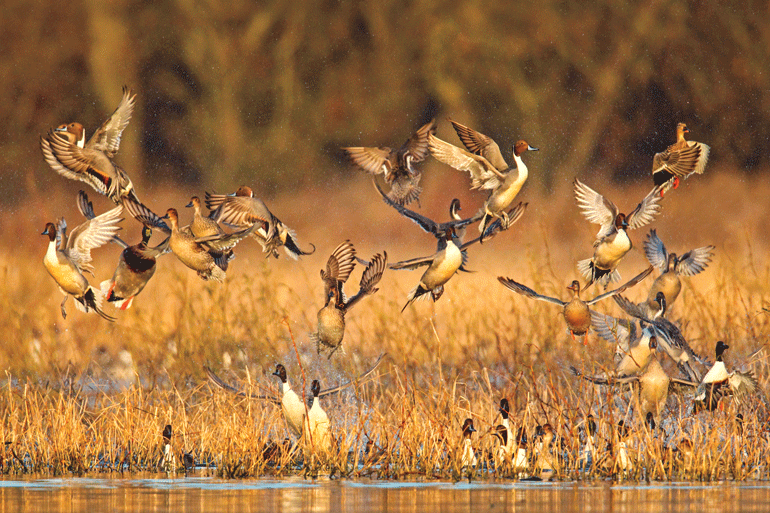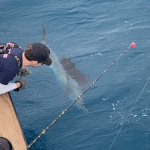Article Courtesy: wildfowlmag.com | Written by: Jace Bauserman | Click here for original article
Whether you’re planning a few blacktop-burning waterfowl sojourns or scheduling close-to-home hunts, your eyes will likely scan multiple waterfowl outlook, migration, population and hunter harvest reports over the next several months. Good. Data is important and can be a contributing factor in helping you decipher when and where to strike. With that noted, it’s important to remember that much of the intel you’re digesting is of the “estimate” or “general” sort.
Let’s first dive into a duck hunter favorite: waterfowl migration maps and updates. There are multiple migration trackers out there. Numerous states have their own, and, of course, DU and Delta update theirs regularly. How is the data obtained? According to DU’s Chris Jennings, the Ducks Unlimited Migration Map receives roughly 20,000 publicly submitted reports from Sept. 1 through Jay 31.
“The map also receives roughly 80 posts that are considered Migration Alerts,” Jennings said. “These reports are professionally written, come from every state and are submitted by freelance contributors, state agency waterfowl managers and DU biologists.”
Intel from these migration maps is typically solid. They stem from in-the-field reports and can be used as a general guide. With that noted, it’s important to remember that the reports aren’t gospel. It happens every year. A migration map shows a strong influx of birds moving into this area or that. One hunter notes the action is heavy while another asks: Where are the birds?
Trumping your migration map watching, whether you’re hunting close to home or headed to a new hunt locale, should be your weather app.
“Waterfowl, minus a few species like blue-winged teal, are wired to migrate only as far as necessary for them to find food, open water and places to rest,” said DU Chief Scientist Dr. Tom Moorman. Moorman went on to tell that many hunters miss an influx of birds because they expect a migration to happen too soon after a cold front. He noted it may take multiple days of freezing temperatures and snow to push ducks along their migration route.
“If open water exists and snow doesn’t blanket food sources, birds will hold,” Moorman continued. “Mortality from migration is common, and fowl can reduce the risk of this by holding closer to their spring breeding grounds.”
It’s generally agreed that winter conditions over the past few years have been milder across much of the country, which may be the answer to the “where the hell are all the ducks” question asked by countless waterfowl hunters each fall.
Moorman did add that hunters should try and plan post-front hunts as opposed to trying to catch ducks moving ahead of weather systems. His reason? The favorable tail winds that come on the heels of most cold fronts.
“If you’re a student of weather, you know winds usually remain favorable out of the north for at least two days after a fall cold snap, and sometimes up to three- or four-days before shifting out of the west or south again. The ducks know this too, and will use these winds to help ease the stress of the migration.”
In addition to your weather studies, pay attention landscapes and never rest on previously gleaned land knowledge. Crop rotation happens, and, sadly, wetlands get disturbed. Some states have lost up to 90 percent of their wetlands over the past 200 years. In my little slice of the world, three sand pits, all of which held throngs of migrating fowl, were filled in this past summer. The total acreage of these wetlands wasn’t much, but being from an area that’s often crippled by droughts that lead to reservoir drainage, they were vital.
“Rapid landscape change—either positive or negative—can directly affect the number of ducks that hold and migrate through an area,” said Moorman. “Some locations will be hot spots simply because they have food and good resting areas. If the weather doesn’t get too nasty in these locations, guys and gals will experience solid hunting throughout the season.”
Population data is something else us duck nuts like to chew on, especially if we are headed to a hunt destination we’ve never been too before. One of the best resources is the annual Waterfowl Population Status Report put forth by the U.S. Fish and Wildlife Service. It’s an amazing document loaded with data. Of course, it’s great when duck numbers are up, but that doesn’t necessarily mean you’ll be busting wings left and right.
Dr. Mike Brasher, a waterfowl scientist for DU, recently crunched some numbers and the results proved interesting. Brasher and his team limited their analysis to areas within the Central and Mississippi Flyways, and discovered only one occurrence where a population-level characteristic was positively related to annual hunter success. Something to keep in mind.
What about those hunter success rate numbers? How valuable is a state’s annual total duck harvest and number of ducks taken per hunter? Not very. In many states, hunters are asked if they bagged between 0 and 10 ducks or more than 10 ducks. That provides hunters a very “general” estimate.
What’s the take away? Duck data is important. Migration maps and the like are fun to watch and provide a general MRI (most recent information) of an area. Weather is a key factor to knowing when are where to launch a duck assault and a solid population doesn’t necessarily mean you’re in for a killer season. Hunter success reports are mostly vague and changing landscapes will directly affect the number of birds in a given area.
Your best asset this season will be your grit and no-quit attitude. Don’t not-go because the migration map showed little bird activity. Don’t cancel your road trip because hunter success appeared dismal in the area last season. You wait all year for these next few months. Make the most of them. Get out and shoot some ducks.






